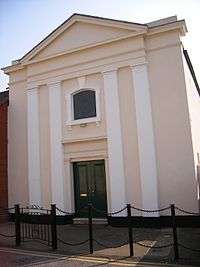Cheltenham Synagogue

The Cheltenham Synagogue is a synagogue in Cheltenham noted for its Regency architecture. It is an independent congregation located in the town centre on Synagogue Lane, off St James's Square.
Nikolaus Pevsner judges that the Cheltenham Synagogue is one of the architecturally "best" non-Anglican ecclesiastical buildings in Britain.[1] It is a Grade II* listed building; the listing calls it "An outstanding example of a small provincial English synagogue".[2]
History
The congregation first met in about 1820 in a hired space at the St George's Place entrance to Manchester Walk.[3][4] The cornerstone for the synagogue was laid on 25 July 1837.[3] Founded when Cheltenham was a popular spa town, the synagogue declined with the town itself and closed in 1903.[5][6] It reopened in 1939 to serve evacuees being housed in London, refugees from Nazi-occupied Europe and soldiers stationed in nearby bases, including a number of Americans.[6]
Architecture
The elegant Regency building was designed by architect William Hill Knight (1837–9) who also designed the Cheltenham Public Library, now the Cheltenham Art Gallery and Museum[7] and Montpellier Walk.
The synagogue's chaste, Regency facade features Doric pilasters and a pediment. The interior features a coffered saucer dome – a typically Regency feature. At the centre of the dome a lantern made by Nicholas Adam provides natural light. The Georgian Torah ark and bimah are reused elements of the London New Synagogue in Leadenhall Street, of 1761:[8] that congregation was in the process of building a new building, dedicated in 1838. The cost of wagon freight from London was £86.[7]
A number of unusual elements of the original furnishings survive. Among these are the original rattan upholstery of the pews and bimah seats, and the prayer boards. One has the Yom Kippur prayers and the other has the prayer for the welfare of Queen Victoria. Victoria's name is superimposed over the names of previous British monarchs, the earliest of which is George II.[7]
References
- ↑ Nikolaus Pevsner, The Buildings of England, Penguin Books, 1951, p. 37
- ↑ Historic England. "Details from image database (475869)". Images of England. Retrieved 21 April 2015.
- 1 2 John Goding, Norman's history of Cheltenham, Longman, 1863, p. 472.
- ↑ Alfred Landseer, A panoramic sketch of Cheltenham and its environs, Longman, 1828, p. 40.
- ↑ Gwen Hart, A history of Cheltenham, A. Sutton, 1981, p. 218.
- 1 2 "Archived copy". Archived from the original on 2009-09-07. Retrieved 2009-06-30.
- 1 2 3 Sharman Kadish, Jewish Heritage in England: An Architectural Guide, English Heritage, 2006, pp. 100–101
- ↑ Renton, Peter (2000). The lost synagogues of London. Tymsder Publishing. pp. 45–46. ISBN 0-9531104-2-7.
External links
- Official website
- Cheltenham Hebrew Congregation on Jewish Communities and Records – UK (hosted by jewishgen.org).
Coordinates: 51°54′01″N 2°04′50″W / 51.9003°N 2.0806°W